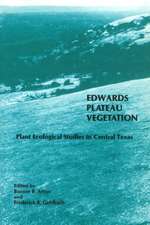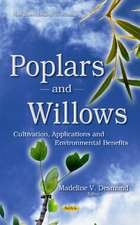Phylogeny and Evolution of the Angiosperms: Revised and Updated Edition
Autor Douglas Soltis, Pamela Soltis, Peter Endress, Mark W. Chase, Steven Manchester, Walter Judd, Lucas Majure, Evgeny Mavrodieven Limba Engleză Hardback – 24 ian 2018
Although they are relative latecomers on the evolutionary scene, having emerged only 135‒170 million years ago, angiosperms—or flowering plants—are the most diverse and species-rich group of seed-producing land plants, comprising more than 15,000 genera and over 350,000 species. Not only are they a model group for studying the patterns and processes of evolutionary diversification, they also play major roles in our economy, diet, and courtship rituals, producing our fruits, legumes, and grains, not to mention the flowers in our Valentine’s bouquets. They are also crucial ecologically, dominating most terrestrial and some aquatic landscapes.
This fully revised edition of Phylogeny and Evolution of the Angiosperms provides an up-to-date, comprehensive overview of the evolution of and relationships among these vital plants. Incorporating molecular phylogenetics with morphological, chemical, developmental, and paleobotanical data, as well as presenting a more detailed account of early angiosperm fossils and important fossil information for each evolutionary branch of the angiosperms, the new edition integrates fossil evidence into a robust phylogenetic framework. Featuring a wealth of new color images, this highly synthetic work further reevaluates long-held evolutionary hypotheses related to flowering plants and will be an essential reference for botanists, plant systematists, and evolutionary biologists alike.
This fully revised edition of Phylogeny and Evolution of the Angiosperms provides an up-to-date, comprehensive overview of the evolution of and relationships among these vital plants. Incorporating molecular phylogenetics with morphological, chemical, developmental, and paleobotanical data, as well as presenting a more detailed account of early angiosperm fossils and important fossil information for each evolutionary branch of the angiosperms, the new edition integrates fossil evidence into a robust phylogenetic framework. Featuring a wealth of new color images, this highly synthetic work further reevaluates long-held evolutionary hypotheses related to flowering plants and will be an essential reference for botanists, plant systematists, and evolutionary biologists alike.
Preț: 505.82 lei
Preț vechi: 549.80 lei
-8% Nou
Puncte Express: 759
Preț estimativ în valută:
96.80€ • 100.69$ • 79.91£
96.80€ • 100.69$ • 79.91£
Carte disponibilă
Livrare economică 24 martie-07 aprilie
Livrare express 07-13 martie pentru 97.10 lei
Preluare comenzi: 021 569.72.76
Specificații
ISBN-13: 9780226383613
ISBN-10: 022638361X
Pagini: 590
Ilustrații: 60 color plates, 36 halftones, 129 line drawings, 18 tables
Dimensiuni: 216 x 279 x 36 mm
Greutate: 2.33 kg
Ediția:Revizuită
Editura: University of Chicago Press
Colecția University of Chicago Press
ISBN-10: 022638361X
Pagini: 590
Ilustrații: 60 color plates, 36 halftones, 129 line drawings, 18 tables
Dimensiuni: 216 x 279 x 36 mm
Greutate: 2.33 kg
Ediția:Revizuită
Editura: University of Chicago Press
Colecția University of Chicago Press
Notă biografică
Douglas Soltis and Pamela Soltis are distinguished professors in the Florida Museum of Natural History at the University of Florida. Together, they are coeditors of multiple books, including Polyploidy and Genome Evolution and, with Jeff J. Doyle, MolecularSystematics of Plants. Peter Endress is professor emeritus of botany at the University of Zurich. He is the author of Diversity and Evolutionary Biology of Tropical Flowers and coeditor of Early Evolution of Flowers. Mark Chase is former director of the Jodrell Laboratory at the Royal Botanic Gardens, Kew. He is the author of Orchids: The Pictorial Encyclopedia of Oncidium. Steven Manchester is curator in the Division of Paleobotany at the Florida Museum of Natural History and one of the leading paleobotanists in the world. Walter Judd is distinguished professor emeritus in the Department of Biology at the University of Florida and affiliate curator in botany at the Florida Museum of Natural History. He is coauthor of Plant Systematics: A Phylogenetic Approach. Lucas Majure is a biologist of New World succulents at the Desert Botanical Garden in Arizona. Evgeny Mavrodiev is an associate scientist at the Florida Museum of Natural History.
Cuprins
Chapter 1. Relationships of Angiosperms to Other Seed Plants
Chapter 2. The Age and Diversity of Early Angiosperms: Integration of the Fossil Record and Molecular Dates
Chapter 3. Phylogeny of Angiosperms: An Overview
Chapter 4. The ANA Grade
Chapter 5. Magnoliids and Chloranthales
Chapter 6. Character Evolution: The Ancestral Angiosperm and General Trends
Chapter 7. Monocots
Chapter 8. Eudicots (+ Ceratophyllaceae): Introduction and Early-Diverging Lineages
Chapter 9. Core Eudicots: Introduction, Gunnerales, and Dilleniales
Chapter 10. Superrosids
Chapter 11. Superasterids
Chapter 12. Angiosperm Classification
Chapter 13. Parallel and Convergent Evolution
Chapter 14. Floral Diversification
Chapter 15. The Evolution of Genome Size
Chapter 16. Polyploidy
Descriptions of Major Clades
Acknowledgments
Reference List
Index
Chapter 2. The Age and Diversity of Early Angiosperms: Integration of the Fossil Record and Molecular Dates
Chapter 3. Phylogeny of Angiosperms: An Overview
Chapter 4. The ANA Grade
Chapter 5. Magnoliids and Chloranthales
Chapter 6. Character Evolution: The Ancestral Angiosperm and General Trends
Chapter 7. Monocots
Chapter 8. Eudicots (+ Ceratophyllaceae): Introduction and Early-Diverging Lineages
Chapter 9. Core Eudicots: Introduction, Gunnerales, and Dilleniales
Chapter 10. Superrosids
Chapter 11. Superasterids
Chapter 12. Angiosperm Classification
Chapter 13. Parallel and Convergent Evolution
Chapter 14. Floral Diversification
Chapter 15. The Evolution of Genome Size
Chapter 16. Polyploidy
Descriptions of Major Clades
Acknowledgments
Reference List
Index
Recenzii
“[One of the] most significant books on flowering plant phylogeny and systematics to come out in recent years. . . . This book belongs on the bookshelf of any serious plant systematist—it will be a valuable resource for years to come.”
“Takes a unique but much needed approach to describe the phylogeny, systematics, and evolutionary patterns of flowering plants. The volume represents a major systematic contribution. . . . The book’s goals are to review the molecular phylogeny of all flowering plants and use this information to inform systematics and our understanding of major evolutionary trends; in this it succeeds admirably. . . . I find it challenging to criticize this book: it is a really well‐organized and well‐presented compendium, filling an important niche. . . . It will be a valuable reference for every botanist and many ecologists, and compelling reading for anyone who works on plant morphology, systematics, and evolution. It will be an important source of ideas and phylogenetic information for future higher‐level systematic and comparative studies of flowering plants.”
“An important and very helpful book and a must for every plant systematist.”
“No endnote to a finished project, but rather, a dynamic and synoptic state-of-the-union of the ongoing effort by many botanists. . . . A necessary reference. . . . It is encyclopedic in its treatment of the subject matter and the lengthy list of works cited makes it an excellent source book for anyone hoping to begin broad phylogenetic study.”
“Excellent . . . highly recommendable for anyone involved in plant systematics.”
“The authors present scholarly and lucid discussions of topics ranging from parallel and convergent evolution to the evolution of genome size and base chromosome number. . . . Fascinating reading, not only for the answers it provides to many . . . curiosities about plant evolution, but also for the scholarly discussion of those questions still awaiting answers.”










